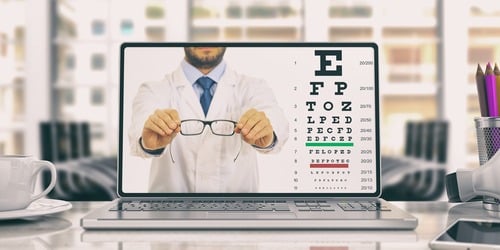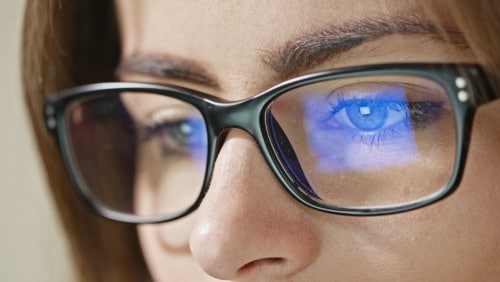How to Create the Optimal Work Environment to Reduce Digital Eye Strain
Eye strain slowing you down at work? Learn solutions to prevent computer vision syndrome, including glasses for computer use like blue light blocking glasses.
How to Create the Optimal Work Environment to Reduce Digital Eye Strain
Your job requires you to look at screens – perhaps multiple screens – a day for extended periods of time. From a desktop or laptop to your cell phone or tablet, your job must be completed via the use of digital, blue light-emitting devices.
And, as you may guess, you’re not alone.
According to the Vision Council, approximately 80 percent of American adults report using digital devices for more than two hours per day. On top of that, about 67 percent reported using two or more devices simultaneously.1
The result of all this use? 70 percent of adults report suffering from digital eye strain.2
While there is no way of avoiding staring at digital screens for the vast majority of your work week, there are multiple ways you can create an optimal work environment that not only reduces eye strain, but also helps your eyes achieve comfort while you work.
What is Digital Eye Strain, Exactly?
Digital Eye Strain – also known as Computer Vision Syndrome – is a condition that encompasses a group of eye and vision-related problems that develop from prolonged digital screen use, such as a computer, cell phone, e-reader, etc.
While Computer Vision Syndrome (CVS) is common and growing in occurrence among individuals of all ages, including children, it is treatable and preventable.
Generally speaking, the level of discomfort depends on an individual’s current eye health, visual abilities, and the amount of time spent looking at a digital screen. Overall,
CVS symptoms tend to increase with the amount of digital screen use.
Computer Vision Syndrome Symptoms & Causes
The most widely experienced symptoms associated with CVS are:
- Blurred Vision
- Eyestrain
- Dry Eyes
- Neck, Back and Shoulder Pain
- Headaches
But what causes digital eye strain in the first place? Research has shown that CVS symptoms are most commonly caused by:3
- Improper Viewing Distances
- Poor Seating Posture
- Poor Environment Lighting
- Poor Screen Lighting
- Glare on the Digital Screen
- Uncorrected or Undetected Vision Issues, such as farsightedness, an astigmatism, presbyopia, inadequate eye focusing or coordination abilities, and more
- A Combination of These Factors
Computer Vision Syndrome Can Be Prevented
Symptoms and causes of digital eye strain are usually only temporary and will cease after digital screen use has ended for an extended period of time. More importantly, CVS can be avoided in the workplace.
With the average American professional spending an average of seven hours a day on the computer,3 and a total of 10 hours a day on all digital devices,4 prevention techniques at the office can go a long way.
8 Ways to Prevent Computer Vision Syndrome & Achieve Eye Comfort While Working
To help alleviate or prevent digital eye strain altogether, turn the following steps into everyday habits:
1. Wear Glasses for Computer Use, such as Blue Light Blocking Glasses
Regardless if you already have a prescription for eyeglasses or contracts, it’s advantageous to discuss your options in glasses for computer use with your optometrist, including blue light blocking glasses.
Special computer glass lenses that have an anti-reflective coating and work to shield your eyes from harmful blue light can give your eyes the most amount of support.
Glasses for computer use:
- Reduce screen glare
- Help you avoid eye strain, eye fatigue, and general eye discomfort
- Can deliver the best correction for intermediate and close-up distances from digital screens
2. Adjust Work Station Ergonomics
How far your computer screen is from your eyes plays a significant role in how much strain your eyes will experience.
In addition to adjusting your own posture, as this will help improve your overall comfort while working, be sure to arrange your desk so your computer screen is 18 to 30 inches (ideal range is 20 to 24 inches) away from your eyes.
Last of all, adjust the center of your screen to be approximately 10 to 15 degrees below your eyes. This will help your neck and head to rest at a more comfortable position.
3. Correct Office Lighting
A major culprit to digital eye strain is not in the digital device at all. If your work environment is extremely bright – due to overhead lighting and/or light coming through the windows – your eyes are probably overworking to adjust to surrounding light and the lighting from your digital device.
As a general rule, when using the computer, your office’s ambient lighting should be about half as bright as what is typically found in most offices. While this is largely out of your control, there are ways you can try to correct your office lighting, such as:
- Closing drapes, shades or blinds to reduce or eliminate exterior light
- Using fewer or lower intensity light bulbs or fluorescent tubes to reduce interior lighting
- Turning off overhead fluorescent lights and using floor lamps that give off indirect incandescent or halogen lighting
4. Reduce Direct or Reflected Glares
In conjunction with correcting office lighting, you’ll want to be sure the steps you take are also reducing glare.
Glares appear when there is a high contrast between the intensity of light in the foreground and background.
You can reduce direct or reflected glare in your workspace by:
- Completing all the steps for correcting office lighting
- Positioning your computer monitor so the windows are off to the side
- Changing office furniture and walls to neutral and dark colors to further reduce glare and reflection
- Using an anti-glare screen filter on your computer screen
5. Change the Text Size and Color Combination on Your Computer
In addition to battling glare, screen flicker, and blue light, your eyes are trying to read small text and understand digital color combinations.
To help your eyes help you, adjust your text to be three times the smallest size you can read from a normal viewing position.
By also working to avoid low contrast text and background color schemes, your eyes won’t experience as much strain. Your eyes like the traditional dark-on-light combinations, such as black text on a white or slightly yellow background, so try to stick to that.
6. Prevent Dry Eyes
Another double-whammy to your eyes is viewing a digital screen for a long period of time while contending with dry eyes.
If you experience dry eyes at work, or know you live with persistent dry eyes, you can:
- Use artificial tears
- Blink more often
- Lower the position of the computer monitor so more of the eye surface is covered by the eyelid because it is looking down
- Increase the amount of water you consume to keep your eyes, and entire body, well hydrated
7. Follow the 20-20-20 Rule
Promoted by the American Optometric Association, the 20-20-20 rule is extremely simple and effective:
Take a 20-second break to view something 20 feet away every 20 minutes.
This exercise will give your eyes a break and help break up time spent staring at a digital screen. It will also give your mind some down time, too.
8. Schedule an Annual Eye Exam
With as much as you rely on your eyes, it’s imperative you get an annual, comprehensive vision exam to ensure your vision is in optimal condition and, if you are contending with any vision conditions, they can be detected early and treated with corrective solutions or preventative strategies.
As noted above, your optometrist can help ensure you get the right glasses for computer use, such as blue light blocking glasses, which has the potential to drastically reduce digital eye strain.
Protect Your Vision with Computer Vision Treatment
At iCare Vision, we take digital eye strain seriously. You can protect your eyes
and achieve comfortable vision while viewing your digital screens.
If you are experiencing any signs of digital eye strain, schedule a healthy eye exam for a quick and painless assessment. We can help you return to a productive workday with more comfortable eyes.
Resources:
1 The Vision Council. Digital Eye Strain. Accessed October 29, 2018. https://www.thevisioncouncil.org/content/digital-eye-strain.
2 NBC News. Read it and blink: 70 percent of adults report ‘digital eye strain’. Accessed October 29, 2018. https://www.nbcnews.com/health/health-news/read-it-blink-70-percent-adults-report-digital-eye-strain-flna2D11883909.
3 American Optometric Association. Computer Vision Syndrome. Accessed October 30, 2018. https://www.aoa.org/patients-and-public/caring-for-your-vision/protecting-your-vision/computer-vision-syndrome.
4 CNN. Americans devote more than 10 hours a day to screen time, and growing. Accessed October 30, 2018. https://www.cnn.com/2016/06/30/health/americans-screen-time-nielsen/index.html.










